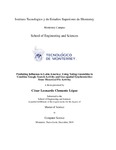| dc.contributor.advisor | Ortiz Bayliss, Jose Carlos | |
| dc.creator | Clemente Lopez, César Leonardo | |
| dc.creator | https://orcid.org/0000-0001-8939-8841 | |
| dc.date.accessioned | 2020-03-14T01:26:29Z | |
| dc.date.available | 2020-03-14T01:26:29Z | |
| dc.date.created | 2018 | |
| dc.identifier.citation | Clemente, L., Ortiz Bayliss, J. C., & Santillana, M. (2019). Predicting Influenza in Latin America: Using Voting Ensembles to Combine Google Search Activity and Geo-spatial Synchronicities from Historical Flu Activity. | es_MX |
| dc.identifier.uri | http://hdl.handle.net/11285/636274 | |
| dc.description.abstract | Novel influenza surveillance systems in the U.S. that combine historical influenza reports from hospitals, along with external influenza-related sources (such as web-based databases and reports from neighboring locations, among others) have shown to generate flu estimates in advance to the official health reports published by healthcare-based systems. However, in Latin America, several systems that harnessed web-based data sources in the past, such as Google Flu Trends, have shown that novel influenza surveillance are yet to deliver acceptable flu estimates. In this work, we aim to show that improved influenza estimates can be achieved for various countries in Latin America, and even in more refined geographic-scales in Mexico, by implementing methodological changes on the way that information sources such as Google Search activity and historical influenza activity reports are combined. A methodological framework which dynamically combines different influenza tracking techniques via a voting ensemble system is presented and used to generate improved influenza activity estimates in 15 countries in Latin America, 5 regions and 27 states in Mexico. Our results show that the voting ensemble outperforms the 3 different techniques implemented to harness the predictive power of local and external data sources, reaching lower error and higher correlation scores. This methodology may prove helpful to local public health officials who organize health interventions aimed at mitigating influenza outbreaks, and its adaptive power may also prove useful to extend its scope by also tracking other diseases such as Dengue and Zika. | es_MX |
| dc.format.medium | Texto | es_MX |
| dc.publisher | Instituto Tecnológico y de Estudios Superiores de Monterrey | esp |
| dc.relation.isFormatOf | versión publicada | es_MX |
| dc.rights | Open Access | es_MX |
| dc.rights | Atribución-CompartirIgual 4.0 Internacional | * |
| dc.rights.uri | http://creativecommons.org/licenses/by-sa/4.0/ | * |
| dc.subject | INGENIERÍA Y TECNOLOGÍA | es_MX |
| dc.subject.lcsh | Science | es_MX |
| dc.title | Predicting Influenza in Latin America: Using Voting Ensembles to Combine Google Search Activity and Geo-spatial Synchronicities from Historical Flu Activity | es_MX |
| dc.type | Tesis de Maestría / master Thesis | es_MX |
| dc.contributor.committeemember | Amaya Contreras, Ivan Mauricio | |
| dc.contributor.committeemember | Conant Pablos, Santiago Enrique | |
| dc.contributor.mentor | Santillana, Mauricio | |
| dc.publisher.institution | Instituto Tecnológico y de Estudios Superiores de Monterrey | es_MX |
| dc.subject.keyword | flu | es_MX |
| dc.subject.keyword | machine-learning | es_MX |
| dc.subject.keyword | disease forecasting | es_MX |
| dc.contributor.institution | Campus Monterrey | es_MX |
| dc.description.degree | Master of Science in Computer Science | es_MX |
| dc.audience.educationlevel | Investigadores/Researchers | es_MX |
| dc.relation.impreso | 2019-12 | |


